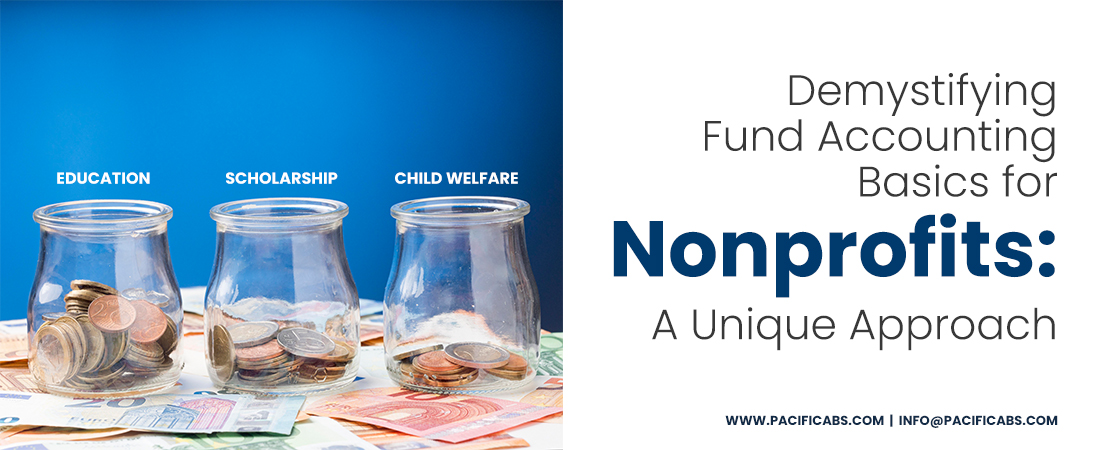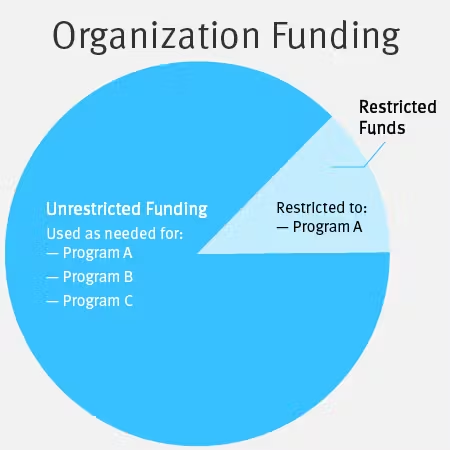
https://www.pacificabs.com/knowledge-center/blog/demystifying-fund-accounting-basics-for-nonprofits-a-unique-approach/
You receive donations or grants designated for a specific purpose that you have to spend within a calendar year. For instance, if you receive a donation explicitly for cancer suffering children, you can’t use that fund for HIV or any other life-threatening diseases.
As you are not free to use funds however you please, it is called restricted funds or donor-designated funds. The complexities of restricted funds present unique nonprofit bookkeeping and accounting challenges, which is not the case in regular accounting.
To respond to these challenges, fund accounting is apparent for nonprofits.
Fund Accounting Basics for Nonprofits: The Heartbeat of Financial Transparency
Fund accounting for nonprofits is arguably more complicated than regular accounting for businesses due to their specific applications.
Fund accounting tracks and manages restricted funds to maintain a degree of transparency and accountability while sharing the statement of financial position to board members, donors, government entities, and the public. While regular or traditional accounting track and measure business’s overall financial performance.
To put it simply, fund accounting categorizes incoming funds and grants into different buckets for different use cases with individual financial statements. This approach gives clarity to your employees and volunteers on how to use funds effectively.
Moreover, donors and supporters can rest assured that their contributions are being channeled precisely as intended, fostering a deep sense of connection to your nonprofit’s mission and a bustling momentum toward shared goals.

For instance, you run an organization that provides well-managed, service-enriched, affordable housing to low-income residents. One program you offer is an After School Tutoring program that provides educational activities to keep resident children and teens engaged and supported in their schooling.
Let’s say that you receive $10,000 fund that a donor earmarked for After School Tutoring program. You need to put that fund in After School Tutoring bucket to use for tutoring, supported reading, computer and internet access, computer educational programs, and an extensive reading library.
The FASB mandates that you set up at least 2 distinct “funds” within your accounts, tracking assets with and without donor-imposed restrictions. Beyond that, you need to track grants, endowments, or substantial funders. This facilitates you to run fund-level reports to share with your supporters.
| Statement of Activities | ||||
|---|---|---|---|---|
| Particulars | Unrestricted | Restricted | Temp. Restricted | Total |
| Income | – | – | – | – |
| New Member Dues | – | $250,000 | – | – |
| Fund Raising Activities | $10,000 | – | – | – |
| Event Ticket Buyout | – | – | $15,000 | – |
| New Member Fees | – | $100,000 | – | – |
| Transfer Fees | – | $60,000 | – | – |
| Total Income | $10,000 | $410,000 | $15,000 | $435,000 |
| Expenses | – | – | – | – |
| Dues, Tuition, & Subscription | – | – | $10,000 | – |
| Gifts & Bonuses | – | $80,000 | – | – |
| Utilities | – | $25,000 | – | – |
| Photocopy & Printing | $5,000 | – | – | – |
| Payroll Fees | – | $200,000 | – | – |
| Total Expenses | $5,000 | $305,000 | $10,000 | 320,000 |
| Net Operating Income | $5,000 | $105,000 | 5,000 | 115,000 |
So, what are temporarily restricted funds?
Taking the above example, if you get $8,000 with the stipulation that the organization must use it to fund a computer educational program for the next school year.
Fast forward to the end of the school year, and your organization is able to use only $5,000 for a program. Now, what happens to the remaining $3,000?
The remaining $3,000 becomes unrestricted. That means it is restricted to only a certain period of time.
Is Fund Accounting a Good Fit for Your Organization?
Yes, your organization is tax-exempt. Even organizations that are not tax-exempt but have charitable causes can use fund accounting.
Government Entities
Government bodies will be the last thing that comes to your mind when you think of nonprofit and charitable organizations. However, government entities, including federal, state, and local bodies, lean on fund accounting to allocate taxpayer contributions and track expenses for projects, programs, and essential services.
By segregating governmental funds, proprietary funds, and fiduciary funds, fund accounting allows governments to demonstrate their commitment to fiscal responsibility and adherence to legal standards.
Educational Institutions
Educational institutions, such as public and private schools or universities, require fund accounting to ensure transparent and effective management of their diverse revenue streams, including tuition, grants, and donations. They often manage very large endowments consisting of hundreds or thousands of individual donor restricted gifts.
Educational institutions need to track and allocate funds for specific purposes, including academic programs, facilities, or scholarships.
Religious Institutions
Churches manage a multitude of funds. But there’s always a big question how much funds these institutions must set aside for new choir robes, a playground, or a small renovation. At the same time, too many buckets lack flexibility in how to cover daily operations. Plus, insufficient funding for a specific project result in financial resources going nowhere shortly.
Fund accounting for churches and other faith-based institutions track and manage mission funds, building funds, and general funds through a true chart of accounts. These funds allow religious institutions to allocate tithes and offerings properly.
Nonprofit Organizations
Nonprofit organizations, such as charities, environmental organizations, sport clubs, and foundations, need fund accounting to manage donations, grants, contracts, and other financial resources earmarked for specific purposes.
Fund accounting method helps ensure that financial resources are utilized according to donor restrictions and regulatory requirements, promoting trust and transparency with donors.
Pro Tip: “By relying on Fund Accounting, you do not need to set up a separate bank account for grants, events, membership program, in-kind donation, and more. Segregate and track them effortlessly in your accounting software or Excel spreadsheet.”
Clarity Amidst Complexity of Fund Accounting for Nonprofits
Nonprofit accountants do not have to set up a separate fund for each program activity, or grant received by your organization. Instead consolidate funds for programs and activities to gain clear insights, seamlessly establish precise budgets for each program activity, and track reserve funds for specific purposes.
Also, there’s no need to set up separate cash or bank accounts and maintain discrete receivables or payables for revenue and expenses related to the fund. Combine cash accounts in a single bank account and manage receivables and payables in the general fund.
Fund accounting will help you to track the accountability of each fund and ensure usage according to the restrictions set by donors, counties, federal, sponsors, and grants. Now, you have master fund accounting, let it empower your organization to create positive impact in the communities you serve.



